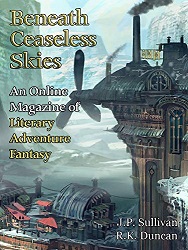 Beneath Ceaseless Skies #267, December 20, 2018
Beneath Ceaseless Skies #267, December 20, 2018
“A Martyr’s Art” by J. P. Sullivan
Reviewed by Gyanavani
The first time I read this ezine was when I reviewed it in September/October of this year and I absolutely enjoyed it. But the last issue of Beneath Ceaseless Skies for this year is unimpressive.
In “A Martyr’s Art,” J. P. Sullivan has created a world where Martyrs, regular people blessed/cursed with the power to absorb the physical pain of anyone they choose to, form a guild. These Martyrs were created from the pain and sacrifice of the goddess Amra. Her hundred tears have created a hundred Martyrs, never more, never less. Every day a Martyr dies and every day the mark of the Martyr appears on some unsuspecting person and s/he then becomes a member of the Guild to be sold in contract to some rich and powerful person able to purchase protection. Thus a god’s sacrifice has become an insurance policy for the corrupt and wealthy.
The heroine, Chalcedony, used to be a street fighter till she got selected. Catapulted into rarefied circles she decides to use her power to push her younger brother into a more economically advantageous position. Her desire to leave behind a financially secure family—a martyr’s lifespan is uncertain—makes her vulnerable to abuse. Throughout the long complex narrative, we see how Chalcedony is brutally treated—as a martyr and as a woman—by men in power. Her own kind do not protect her; in fact, there seems to be some unhealthy competition between the younger/newer martyrs to get the more lucrative contracts which leads to serious bad blood and murderous underhanded dealings. In the end Chalcedony lays her hand on a special prize that gives her great and very rare power—so of course she uses it for her own personal revenge.
And therein lies the central problem of this story. It uses sophisticated story telling techniques to present a cynical world view, an acceptable perspective, but when the author does not offer a corrective opinion, the narrative vision also shrinks to a sordid menial level. Chalcedony is not a likable heroine, again perfectly acceptable, but she’s also not admirable. I am also tired of tough heroines who are scrappy fighters who give as good as they get. In recent times we are so inundated with kick-ass heroines both in print and on screen that she has become a cliché.
In “A Circle of Steel and Bone” R. K. Duncan solves a murder mystery in a medieval monastery located in the wilds of Prussia. The head of this small Christian settlement, an old and thoughtful fighter, Meinrad, has to solve the ritualistic murders of two strong warriors before his crew of hasty, blood thirsty knights take it on themselves to punish the neighboring village of foreign and therefore, suspicious Prussians. Soon we find that the murderer, who does not appear to be choosy, has found a victim in the village too. As Meinrad begins digging, he discovers the older powers that existed before Christianity and finally understands how he can solve the problem.
R. K. Duncan places his story in Europe to point Christianity’s need to define an other that is antithetical and hence always already the antagonist. His main character, Meinrad, is acutely aware that Christianity’s historically savage conversion crusades resulted in suppression, and over time the erasure of local religious beliefs and practices. The story’s problem is an age-old one: lack of clarity and crisp expression.